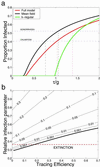Modeling dynamic and network heterogeneities in the spread of sexually transmitted diseases
- PMID: 12271127
- PMCID: PMC130633
- DOI: 10.1073/pnas.202244299
Modeling dynamic and network heterogeneities in the spread of sexually transmitted diseases
Abstract
A wide range of communicable human diseases can be considered as spreading through a network of possible transmission routes. The implied network structure is vital in determining disease dynamics, especially when the average number of connections per individual is small as is the case for many sexually transmitted diseases (STDs). Here we develop an intuitive mathematical framework to deal with the heterogeneities implicit within contact networks and those that arise because of the infection process. These models are compared with full stochastic simulations and show excellent agreement across a wide range of parameters. We show how such models can be used to estimate parameters of epidemiological importance, and how they can be extended to examine the effectiveness of various control strategies, in particular screening programs and contact tracing.
Figures



References
-
- Joint United Nations Program on HIV/AIDS and World Health Organization. AIDS Epidemic Update: December 2001. Geneva: UNAIDS; 2001.
-
- Centers for Disease Control and Prevention. Sexually Transmitted Disease Surveillance, 2000. Centers for Disease Control and Prevention, Atlanta: U.S. Department of Health and Human Services; 2001.
-
- PHLS; DHSS & PS; the Scottish ISD(D)5 Collaborative Group. Trends in Sexually Transmitted Infections in the United Kingdom, 1990–1999. London: Public Health Laboratory Service; 2000.
-
- Piot P, Bartos M, Ghys P D, Walker N, Schwartländer B. Nature (London) 2001;410:968–973. - PubMed
-
- Mollison D. J R Stat Soc B. 1977;39:283–326.
Publication types
MeSH terms
LinkOut - more resources
Full Text Sources
Medical

